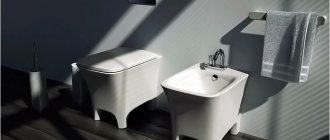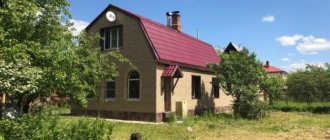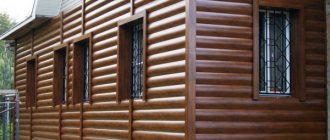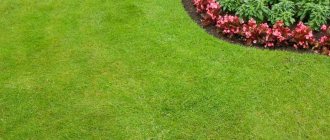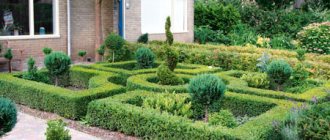Beautiful balusters are the main architectural element in the design of the staircase. These parts allow you to keep the railing upright.
Most often they are used as a support, which allows you to create a strong structure for lifting upwards.
During the manufacturing process, various technological features of industrial production are used.
Finished products have an attractive and aesthetic appearance that can fit into any design direction.
Metal porch railings
Railings perform not only a purely practical function, but also serve as an important element of the porch design.
Such structures can be made of wood, metal or plastic. The carved and forged handrails are incredibly beautiful. Each type of railing has its own advantages and disadvantages.
We’ll talk about how to make the porch as comfortable and beautiful as possible by choosing the most suitable type of handrails in this article. We will also look at the basic principles of making such a fence for a porch.
Functional purpose and positive characteristics
Durable wooden deck balusters perform several important functions. That is why these products must be as durable and reliable as possible.
Main functions of racks:
- used as a support;
- provide the necessary stability to the ladder;
- give the stairs an aesthetically attractive appearance;
- provide the necessary safety for human movement from the first floor to the second.
Balusters made from durable solid wood are very popular among private property owners. High-quality products have the following advantages:
- Wood goes well with all modern finishing materials and interiors.
- Long service life and maximum strength. High-quality racks can last for decades. The minimum service life of solid wood structures is 45 years.
- Environmentally friendly. The material is absolutely safe for the environment and human health, as it does not emit toxic substances into the air. Natural resins have a powerful healing effect.
- Aesthetic appeal. Manufactured stairs can boast of their sophistication and originality. In combination with properly selected decorative finishing, the interior of the room becomes extraordinary and luxurious.
- You can make original racks yourself.
- Huge selection of natural raw materials. Wood is ideal for realizing the most unexpected design ideas.
- Damaged staircase elements can be restored or replaced.
A universal model with an unusual pattern
Wooden handrails
Wooden porch railings are the most common type. Their popularity is explained primarily by their ease of manufacture. Wood is an incredibly light material to process.
In addition, such designs are very convenient to use. Touching wood in the cold is much more pleasant than touching metal. Wooden handrails are often decorated with carvings.
Wooden porch with balusters. Photo of a massive, solid railing structure The disadvantages of this type of fencing include, first of all, the service life that is not very long in comparison with metal structures.
Note: Wooden railings for the porch, unlike PVC and metal options, will require periodic maintenance from the owners of the house. Once a year or two they will have to be tinted.
Flat balusters: step-by-step instructions
Flat supports are easiest to make yourself. Their production does not require complex equipment. Skillfully made supports have an attractive appearance. They can decorate any interior.
Step 1. The first stage of work is devoted to preparing the materials and tools necessary for the manufacture of balusters: jigsaw, paper, marker, scissors, ruler, sandpaper or sanding machine, dry boards or plywood.
Electric jigsaw
Prices for popular models of jigsaws
Jigsaw
Step 2. At the second stage, a sketch of the future support is developed. To do this, the full size of the contours of the product and patterns are applied to the paper. After this, a support template is cut out according to the dimensions marked on the paper.
Stencils
Step 3. The third stage is devoted to applying a stencil to the workpiece, drawing the contours of the future product on it and cutting out a support along them with a jigsaw.
Flat balusters cut with a jigsaw
Step 4. At the fourth stage of work, the surface of the products is processed. For these purposes, use sandpaper or a grinding machine.
Prices for popular models of sanders
Sanders
Sanding a piece of wood with an emery wheel
Step 5. To extend the service life of products, their surface is treated with an antiseptic. After it dries, the supports are coated with wood varnish. This improves their aesthetic appearance.
Features of varnishing stairs
Find out how to make a wooden countertop for a bathroom sink with your own hands in a special article on our portal.
Plastic structures
Plastic is also a fairly “warm” material and easy to cut. How to make a brick border with your own hands? Among other things, it is frost-resistant and resistant to moisture. Cleaning such handrails will not be difficult.
Practical railings for the porch. Photo of an elegant plastic version
Vinyl railings can last longer than wooden ones. Yes, and they are cheaper. However, of course, this material is not natural and cannot be compared with wood in terms of the beauty of its texture.
This option is simply ideal if the design provides for rounded areas. Bending plastic porch railings is very easy. To do this, you just need to heat them with a hair dryer.
Note: The design of PVC handrails is chosen based primarily on the material the porch itself is made of. There are options that imitate both wood and metal.
What type of wood to choose
In order for the staircase to remain strong and presentable for a long time, it is recommended to make all elements: railings, balusters, steps from the same type of wood. When making supports for stairs, it is best to choose hard wood:
- Oak. Noble and strong, it has the highest performance characteristics. It is durable, resistant to temperature changes, moisture and decay. Oak products have a beautiful dark shade. The products practically do not crack or warp. Despite the density of the wood, oak can be processed in all available ways.
Example of carved oak balusters - Ash. It has a very beautiful texture of valuable wood. The main advantage of ash is its resistance to moisture and rot. The structure of the tree is elastic and dense, withstands heavy loads well, bends well, and is resistant to deformation.
- Beech. Beautiful and easy to process, beech is almost as strong and durable as oak. The wood is perfectly polished and sanded, and lends itself well to decorative finishing with various compositions. The disadvantage of beech is its susceptibility to rotting and deformation in places with high humidity. In order for beech products to be of high quality, you need to choose properly dried wood.
- Birch. Rarely used for making balusters. The main disadvantage of birch is its tendency to rot, cracks and severe shrinkage.
Drawings and patterns of birch balusters
Although wood has good strength indicators, it is easy to process, sand and paint. After appropriate processing, birch can be given the appearance of noble wood. - Larch. Over time, wooden larch balusters only become stronger. The wood is resistant to warping and high humidity, it does not rot and burns very poorly.
- Pine. A budget option with good resistance to fungi, moisture and temperature changes. Wood lends itself well to processing with cutting tools and is the most popular material for creating stairs.
To make balusters with your own hands, it is important to choose wood of the correct moisture content, without cracks, knots and other defects. Overdried wood is very fragile, and wet wood can crack after drying.
Various types of carved balusters
It would also be wiser for novice craftsmen to choose inexpensive types of wood - pine or birch, which are easy to process. Valuable species such as oak or walnut are too expensive to be damaged during the training process.
Metal railings
Metal railings are the most durable type. Most often, handrails are made of stainless steel. Exclusive options are cast or forged. Using such designs you can make the porch unusually beautiful and original.
However, wrought iron porch railings are quite expensive. Sometimes in private houses, not iron, but aluminum and stainless steel handrails are used. They are also not too cheap.
Wrought iron railings on the porch. Photo of a complex decor imitating a vine
The disadvantages of metal fencing include some difficulty in installation. Typically, stainless steel porch railing elements are fastened together using welding. Do-it-yourself border from scrap materials? Therefore, for their installation you need to have special equipment.
In addition, painted structures made of non-galvanized steel must be periodically tinted.
Metal railings for the porch. Photo of a simple elegant design
Tools for manufacturing and installation
Indoor stairs are installed in all sorts of styles and various configurations. Balusters and handrails are selected according to the interior and the preferences of the owner. There are enough materials from which protective fences are made, and each has its own devices, tools for manufacturing and installation.
Don't forget to prepare your tools
Metal reinforcements have been used in staircase structures for a long time, but modern designs are more advanced. Stylish curves of lines are ideal in a new way, combined with fashion trends and the spirit of the times.
The structures are installed by a manufacturer who knows all the methods of attaching forged products to the supporting base. The bases of balusters, panels and overlays cannot be done without special machines that work with metal.
When purchasing metal devices for stairs, you can see that the kit includes universal fastening devices. The standard set consists of:
- Brackets or hinges that secure the support to the steps.
- Special metal products - bolts and screws, ready to strengthen the ring and basket.
Concrete railings
Concrete handrails are perhaps the most substantial type of porch fencing. They will last even longer than metal porch railings made of stainless steel, since they have no joints or technological gaps. However, their construction is a somewhat more labor-intensive process.
Among other things, this is also the most expensive type of fencing.
Concrete solid structures can be supplemented with metal handrails
When choosing a material for making railings, be guided primarily by the design of the porch itself. In this case, you will get a harmonious and stylish design. For example, this one:
Other materials in creating balusters
Balusters for stairs and fences located outdoors must have increased strength and resistance to climatic influences. In the creation of massive structures, stone and concrete supporting elements are often used. They withstand high loads and maintain integrity in any conditions.
Stone balusters are used for outdoor stairs
Polymer elements are now often used in the design of stairs. Most often, balusters are made of acrylic and polyurethane. These materials are ideally molded; products can be given any desired shape. A significant advantage is the ability to give the balusters the desired shade. The advantages of such support elements include:
- resistance to any impact;
- minimum weight;
- decent aesthetic indicators;
- easy care;
- durability;
- low price.
Acrylic balusters are resistant to any impact
Plaster is used to create balusters. This is an environmentally friendly, strong and durable material. Gypsum elements fit perfectly into classical styles, Empire, Provence, etc.
Plaster balusters fit perfectly into the classic style
Glass is becoming increasingly popular. The emergence of durable, safe triplex made it possible to design any structure in an original, stylish way. Most often, stainless steel railings are installed on such supports. These materials are ideally combined and fit harmoniously into modern styles.
Harmonious combination of stainless steel railings and glass balusters
How to install balusters on a wooden staircase with your own hands
When constructing stairs in a residential building, it becomes necessary to use railings that simultaneously perform two functions: protective and decorative. The main elements of the railing are handrails and transverse supports called balusters. The greatest difficulty in installing staircases arises when installing balusters. They can be made from a variety of materials, but the most popular ones are wood, glass, concrete, stone, metal and plaster.
The shape of these elements can also be the most unusual, allowing you to emphasize the elegance of the staircases.
Balusters and wood in dark colors
Wooden or metal supports are installed on a wooden staircase. Other materials do not combine well with wood. Transverse supports are installed between the handrails and the material of the steps.
The supports can be mounted in several ways, depending on the material of manufacture. It is quite possible to install any option with your own hands, if you have at least basic construction skills and the necessary tools. Below we will look at how to install balusters made of wood and metal on the stairs.
Technical installation features
To begin with, it is necessary to say that this issue must be approached at the design stage of the structure. Therefore, if the staircase is purchased in the form of separate elements, then this issue should be resolved before purchase. In such cases, the instructions help very well, which are often attached to factory structures and describe all the features of a particular model (see also the article “Finishing concrete stairs with wood - how to carry out the work correctly”).
A graphic manual describing the step-by-step process of installing such systems using standard techniques suitable for a specific model
Safety requirements
- These elements must be installed at a distance of no more than 15 cm from each other. This is especially important if children will use the stairs. This arrangement will not only affect the strength of the system, but will also prevent falls.
Installation of metal pins on which products will be fastened
- Typical fastening of pillars and balusters in a wooden staircase is carried out in such a way that the height of the fence is from 80 to 100 cm. This is considered the optimal solution in choosing between comfort and safety.
- Special attention should be paid to the fact that the products must be fixed both from below and from above. In this case, different installation techniques are used, selected depending on the type of structure and material of manufacture.
Types of fasteners that are used when performing such work
- It's also important to note that the manual that explains how to secure balusters to a wooden staircase strongly recommends using hardware to secure it underneath. Recently, this has become a safety requirement that must be observed when working with wood.
Advice! You should not violate safety precautions even if it is structurally necessary. It has been developed over the years and takes into account all the operating features.
Each type of design requires its own method of fixation, based on certain technical features of the product.
Installation
First of all, lower fixation is performed. To do this, instructions explaining how to install balusters on a wooden staircase recommend using metal studs, special bolts or self-tapping screws. The choice of these products depends on the type of structure and location of attachment.
Only the use of metal elements for fixation will provide the necessary strength, which will also affect the safety and service life of the structure.
Next, you should install the connecting strip, which should have special grooves corresponding to the cross-section of the baluster. In this case, you can use ordinary nails paired with wood glue. After this, a metal plate is attached over the plank to strengthen the structure.
The process of installing railings without using a connecting board and metal reinforcement
Next, the installation of railings and balusters of a wooden staircase enters the final stage. It consists of installing a handrail on the side of the wall, which is fixed from below using self-tapping screws. It is worth noting that there are railings that require their own special method of fastening, which should be clarified in advance.
Advice! Some craftsmen use additional fixation elements in the form of staples or corners. They significantly strengthen the structure, but can harm the appearance.
Additional railings will significantly increase the level of comfort for people with disabilities or children, which is often used in public buildings
Mounting recommendations
- Usually the price of special fasteners is quite high. However, you should not save on it, since the quality of the final product depends on this factor. At the same time, modern craftsmen often duplicate fixation systems in order to be confident in the quality of the structure and its reliability.
Even with a dovetail connection, it is necessary to perform additional fixation using self-tapping screws or special bolts that are inserted into a pre-prepared hole so as not to cause pressure on the assembly
- Before choosing a specific design, it is necessary to consult with the end user, taking into account all his wishes and family composition. It may be necessary to make some changes to the system if the product is used by disabled people or children.
- The thickness of the balusters does not play a special role in terms of safety. The main thing is that the minimum required distance is maintained and the finished structure can withstand the loads expected by operation.
Various options for such products, which will not only serve as security systems, but also give the structure an original appearance
Each type of design requires its own method of fixation, based on certain technical features of the product.
Requirements for the location of balusters
- The size of the crossbars is calculated so that the total height of the railing is at least 90 cm. This is necessary to ensure safety.
- The distance between adjacent supports should be no more than 15 cm.
- The balusters are fastened in two places - to the handrails, as well as to the material of the steps.
- The supports must be strong. They must be able to withstand the weight of an adult who can lean on them.
- All racks must be made strictly from the same material. This is due to the different effects of humidity and temperature on different materials.
- When installing wooden stairs, nails are not used. They will definitely cause squeaks in the future.
Mounting the support post
The methods of fastening and installing the support post are labor-intensive, but it is worth it, since high reliability of the entire structure is achieved. Fastening can be done in two known ways:
- Anchors - a groove of a rather complex shape is cut out at the bottom of the post, into which an anchor is screwed, the diameter of which can be from 5 mm to 16 mm;
- Bayonet nut - to mount it, you will need a special key and washer.
When installing a support column, you must adhere to one rule - the inner wedge of the anchor must be driven in, not twisted. A hole is drilled in the floor into which an anchor is driven with a hammer up to the limiting edge. A supporting baluster is then attached to it.
Features of fastening balusters made of other materials
Installation of wooden balusters
The supports for a wooden staircase are installed with your own hands on the steps or on a string. You must first prepare the fasteners. These can be wooden dowels up to 8 cm long and 1-1.5 cm in diameter.
Metal studs with threads with a diameter of 6-10 mm and a length of 6-10 cm can also be used. It is assumed that the balusters that will be used have already been prepared.
The installation procedure is as follows:
- First, the entry posts are fixed along the edges of the stairs, as well as at the corners. Their height must be at least 1 m.
- Holes for fastening elements are drilled at the ends of wooden balusters. Their diameter should be 2 mm less than the diameter of the fastener.
- The future position of the balusters is marked on the stairs.
- If the supports are mounted on a staircase with a slope, the top of each baluster is cut to a given angle, determined individually. This way it is possible to avoid discrepancies on stairs with large differences. The height of each individual jumper may be different.
- A rope is stretched between the upper cuts of adjacent support pillars, along which the cut angles of the transverse elements are marked.
- On flat areas of the stairs, balusters are installed without trimming.
- Prepared pins or dowels are inserted into the holes of the supports. They are fixed with PVA glue or wood glue.
- Holes for pins are drilled in the steps or in the bowstring.
- Balusters with pins or dowels are inserted into the prepared holes. They can be attached with glue.
- Mounting the supports on the bottom side can be done in another way. To do this, the studs are screwed into the material of the degrees. In these places, holes of smaller diameters are drilled first. Small holes are also drilled on the lower sections of the supports. DIY fence made from plastic bottles photo? After this, the balusters are simply screwed onto the studs fixed in the steps.
- A railing strip is attached to the posts. Typically self-tapping screws are used for this purpose.
- Handrails are attached to the underrail. If the railings are installed using glue, then no marks remain on their upper part. When fastening with self-tapping screws, recesses remain, which should be closed with wooden plugs or filled with epoxy resin.
If self-tapping screws are used as fastening elements, then installing balusters on the stairs is a little easier:
- The posts are measured in place and cut at an angle.
- Corner holes for self-tapping screws are drilled at the bottom and top of the balusters.
- The racks are set strictly according to the markings, after which they are attached from below with self-tapping screws to the steps or bowstring, and from above to the handrail.
- Additionally, the balusters can be secured with self-tapping screws from above, through the handrails.
- The holes left by the screw heads are sealed with wax, glue or wooden plugs.
Wooden mount
Most often, the stairs in the house are decorated with wooden supports. You can install them yourself. The main thing is to follow some rules. Fastening wooden balusters to the floor is done using screws, pins or self-tapping screws. Fasteners must be made exclusively of metal. Otherwise, the fastening of the structure will be unreliable.
Experts recommend not using a threaded connection that becomes loose during operation. You need to opt for active tightening hardware. Nails and wooden dowels should not be used.
To attach the upper part of the balusters, you must first prepare grooves in the handrails. These grooves should be the same size as the top of the vertical supports. As a rule, structural elements are not attached directly to the handrails. A fixing bar is placed on them, and only then a handrail.
The fixing strip and supports are fastened together with pin-headed nails. For reliability, the attachment points can be treated with a special adhesive composition.
If the staircase is installed between two parallel walls or the width of the structure reaches one and a half meters, then the handrails should additionally be attached to the walls. In this case, you need to use special brackets.
It is advisable to opt for vertical supports, the sides of which in sections vary from 3 to 8 cm. Vertical supports must be purchased as a set. No need to skimp on hardware. The reliability of the fastening will depend on them. Therefore, preference should be given to those companies that have been operating on the market for several years and have a good reputation.
This is the simplest mounting option considered. Before fastening it in the balusters, it is necessary to drill holes with a diameter smaller than the screws used. In the upper part, the hole must be widened in order to hide the screw head.
Installation of metal balusters on stairs
Metal balusters can also be installed on wooden stairs. They usually use chrome or forged products. These can be rods, profile and ordinary pipes of different diameters.
They go well with wooden steps and railings, and their service life is very long. In some cases, metal railings are also used in conjunction with metal crossbars.
Metal balusters and railings
The standard height of metal supports is 80-100 cm.
Criteria for choosing balusters
The pillars for the wooden structure are selected from the same material. To create an interesting composition, use lighter or darker shades.
Before fixing the balusters to the wooden floor, determine the type:
Metal balusters are more suitable for spiral staircases. Thanks to them, the design acquires airiness and lightness. They are made by welding; such poles will last a long time. There are:
- With cylindrical or square rods. This type is outdated and can be seen in old multi-story buildings.
- Forged. Combines well with many materials.
- Cast. Durable and versatile variety. It costs less than the previous one.
They have the following advantages:
- long service life;
- ease of maintenance (they lend themselves well to restoration work);
- versatility (can be used indoors or outdoors).
The most popular metal options are stainless steel and cast iron. The first has the following advantages:
- Anti-corrosion properties. Perfect for rooms with sudden temperature changes and high humidity.
- Strength and durability (the latter characteristic depends on the design of the railings themselves).
- Aesthetics.
The disadvantages include the high cost.
Cast iron has the following advantages:
- Versatility. Compatible with a variety of staircases.
- Durability. Does not lose its operational and aesthetic features.
Not every ladder can withstand them, because... they are very heavy.
Before attaching the baluster to the floor and railings, you need to think about tightening hardware. They are used to attach the pillars to the steps. The handrails are mounted on the top with grooves or a fixing film. Brackets are used for fastening to the wall.
They are selected from 0.8 m in height for the safety of everyone who will climb and descend. You can install them yourself, but it is better to entrust this task to professionals.
At the same time, when studying information on how to make balusters, you should simultaneously select drawings and decorative carving options. This will allow you to integrate these decorative elements into the exterior of a building or structure without any problems. An experienced woodcarver can create several options for balusters, the combination of which will add originality to the architectural image of the house.
Installation of forged balusters
Forged elements are usually made to the size of a finished staircase, in the form of spans, rather than individual elements. Do-it-yourself installation involves securing the flights of stairs:
- First, the stairs are marked and the fastening points are marked.
- The lower edges of forged balusters are secured to the ladder or string using fasteners (bolts or self-tapping screws).
- A railing strip is attached to the top of the metal structure, onto which the railings are then glued or screwed.
Common types of durable balusters
Carefully crafted posts from durable natural materials help enhance any staircase. The master can choose the most suitable shape and decorative finish.
Common types of products:
- Square. Such designs look great with classic staircases of standard shapes. Craftsmen often apply various decorative recesses to the side of the racks.
- Round. This is the standard option. The formed columns have a cylindrical shape. The cross-section of the blanks can vary from 2.5 to 6 cm. Durable and durable models are constructed from solid wood and combined with small metal elements.
- Flat. Such products are made from high-quality plywood or boards. The staircase can be not only solid, but also from separate fragments. The racks are decorated with unusual spirals and through patterns.
Important! The easiest way is to make flat balusters for a small staircase. Using a regular jigsaw you can make carved parts.
Experts distinguish three basic types of balusters made of natural wood. Each option differs in production technology:
Reliable homemade stairs
- Classic milling. Craftsmen use high-quality machines and pre-prepared balusters. Using a router, unusual shapes are created.
- Universal turned. This is the most popular and affordable option for processing raw materials. An ordinary wooden block can be given an unexpected shape. The final result depends on the finesse of using the lathe. A wide variety of cutters allows you to quickly and efficiently produce unique products.
- Carved. These are beautiful, sophisticated and expensive balusters. All necessary patterns are created using a CNC unit. Making carved supports yourself is quite problematic, but very exciting.
Modern models made of quality materials
Installation of hollow metal pipes
Modern homes sometimes use lightweight metal lintels that have a chrome or anodized finish. They are quite reliable, quickly installed, and belong to the high-tech design style. Ready-made balusters are purchased that can be adjusted in height. They are installed in the following order:
- The locations of the supports are marked on the steps.
- Metal pipes are installed on the steps, after which they are attached to them using self-tapping screws or bolts. For this purpose, there are round fasteners in the lower parts of the pipes.
- The height and angle of rotation of the upper cradle of each pipe is adjusted manually.
- Railings are attached to the cradle.
The choice of decorative lintels is not limited to just wood or just metal. You can combine these two materials to create an unusual and beautiful design. For example, balusters can be made from thick metal rods, stringing wooden balls on them, drilled in the center.
The result is a beautiful and reliable design. And a sufficient number of such examples can be given.
Technical installation features
To begin with, it is necessary to say that this issue must be approached at the design stage of the structure. Therefore, if the staircase is purchased in the form of separate elements, then this issue should be resolved before purchase. In such cases, the instructions help very well, which are often attached to factory structures and describe all the features of a particular model (see also the article “Finishing concrete stairs with wood - how to carry out the work correctly”).
A graphic manual describing the step-by-step process of installing such systems using standard techniques suitable for a specific model
Safety requirements
- These elements must be installed at a distance of no more than 15 cm from each other. This is especially important if children will use the stairs. This arrangement will not only affect the strength of the system, but will also prevent falls.
Installation of metal pins on which products will be fastened
- Typical fastening of pillars and balusters in a wooden staircase is carried out in such a way that the height of the fence is from 80 to 100 cm. This is considered the optimal solution in choosing between comfort and safety.
- Special attention should be paid to the fact that the products must be fixed both from below and from above. In this case, different installation techniques are used, selected depending on the type of structure and material of manufacture.
Types of fasteners that are used when performing such work
- It's also important to note that the manual that explains how to secure balusters to a wooden staircase strongly recommends using hardware to secure it underneath. Recently, this has become a safety requirement that must be observed when working with wood.
Advice! You should not violate safety precautions even if it is structurally necessary. It has been developed over the years and takes into account all the operating features.
Each type of design requires its own method of fixation, based on certain technical features of the product.
Installation
First of all, lower fixation is performed. To do this, instructions explaining how to install balusters on a wooden staircase recommend using metal studs, special bolts or self-tapping screws. The choice of these products depends on the type of structure and location of attachment.
Only the use of metal elements for fixation will provide the necessary strength, which will also affect the safety and service life of the structure.
Next, you should install the connecting strip, which should have special grooves corresponding to the cross-section of the baluster. In this case, you can use ordinary nails paired with wood glue. After this, a metal plate is attached over the plank to strengthen the structure.
The process of installing railings without using a connecting board and metal reinforcement
Next, the installation of railings and balusters of a wooden staircase enters the final stage. It consists of installing a handrail on the side of the wall, which is fixed from below using self-tapping screws. It is worth noting that there are railings that require their own special method of fastening, which should be clarified in advance.
Advice! Some craftsmen use additional fixation elements in the form of staples or corners. They significantly strengthen the structure, but can harm the appearance.
Additional railings will significantly increase the level of comfort for people with disabilities or children, which is often used in public buildings
Mounting recommendations
- Usually the price of special fasteners is quite high. However, you should not save on it, since the quality of the final product depends on this factor. At the same time, modern craftsmen often duplicate fixation systems in order to be confident in the quality of the structure and its reliability.
Even with a dovetail connection, it is necessary to perform additional fixation using self-tapping screws or special bolts that are inserted into a pre-prepared hole so as not to cause pressure on the assembly
- Before choosing a specific design, it is necessary to consult with the end user, taking into account all his wishes and family composition. It may be necessary to make some changes to the system if the product is used by disabled people or children.
- The thickness of the balusters does not play a special role in terms of safety. The main thing is that the minimum required distance is maintained and the finished structure can withstand the loads expected by operation.
Various options for such products, which will not only serve as security systems, but also give the structure an original appearance
The presence of a thin bowstring does not allow attaching balusters using the method described above, but the issue can be resolved using one rather interesting technique. It requires adding an additional rotating element to the structure, which connects the baluster and the side of the stringer. This maneuver not only increases the free space on the steps, but also allows you to move the fences beyond them.
Places and methods of purchasing decorative stands
The problem of where to buy wooden balusters is not difficult to solve. For this there are construction markets and shops. Online shopping has long been considered a fashionable way to purchase goods.
If you want to decorate the stair railings or the balcony of your house with exclusive carved posts, you can contact a company that produces custom balusters.
Difference in types and main factors influencing cost
To win on price, get a simple look without a top coat. Ordinary turned stands, with ornaments, made on a lathe using various cutters.
More interesting types are twisted supports and carved posts. They can also be purchased in their original form without coating. Their cost will be somewhat lower, although it will still significantly exceed the price of the simplest products.
When varnished, the price will rise accordingly. If you take expensive balusters, it is always better to clearly calculate the required quantity in advance.
The most expensive type of balusters are carved posts. They are made by turning complex multi-program machines or manually to order. Beautiful unique ornaments are created in the form of wooden miniature statues. These can be animals, birds, plants and so on.
Basic decorative functions of balusters
In markets that sell building materials, it is easy to find the products necessary to decorate the exterior of buildings and at the same time the interior.
In this case we will talk about the installation of wooden balusters. They are rightly considered decorative elements. They often act as architectural details that decorate interior structures, or are installed to give the external architectural ensemble an expressive look.
Practical application of products
Balusters are often used as additional supports for railings. Thus, entrance staircases, varieties of internal flights of stairs, fencing of balconies on the upper levels of floors of dachas and cottages, and so on are designed.
Such elements have been used for a long time. Their external shape and main focus make them popular even today.
High interest in balusters manifests itself precisely as construction parts that perform several functions at once. Firstly, as noted, they act as support posts, and secondly, in addition to their direct purpose, they participate in the artistic design of residential buildings and extensions.




